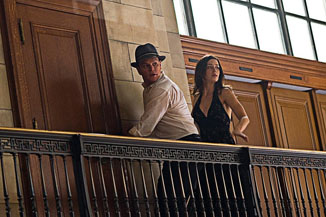|
|
Book vs. Movie: The Adjustment BureauMarch 10, 2011
The fantastic end of things doesn’t really hit until about 20 minutes into the film. Norris is off the bus, walking into his campaign office. There he sees the aforementioned men in fedoras with a group of guys in what appears to be some vague mutation of riot gear. The men he expected to find in the office are completely motionless. They are being subjected to strange lights. A chase ensues and the film begins to bear some stronger resemblance to the story it’s based on. The premise of the film begins to match the premise of the story. Rather than being about a simple mix-up in which the protagonist failed to become “de-energized,” with the rest of the people in his office building, the film focuses on a simple chance meeting between the dancer and the politician. Evidently they can’t be together or things will not go as they should — so says the Adjustment Bureau. Marrying the premise with star-crossed lovers gives the film a beautifully Hollywood kind of heart about it. It’s much easier for audiences to grasp the questions of free will and identity that are posed by the premise when it mixes quite directly with love and politics. The romance wouldn’t be nearly as compelling - it needs to be to hold the center of the film - were it not for the fact that Damon and Blunt do a brilliant job of rendering the a compellingly charming connection in their all-too-brief time together in the first half of the film. As an audience, we kind of want to see them together, which serves to hold the much longer narrative of a film together much better than a casual mix-up at the office likely would have done. The problem with the film is that it lacks the sense of the quirky fantastic that so brilliantly fills the story. We aren’t treated to the kind of intricately surreal visuals that fill the short story. Instead we get a lot of drama and the full force of the premise being delivered almost exclusively in dialogue. The film develops the premise of the story without remaining all that true to the spirit that inspired it. The VerdictPhilip K. Dick’s short story The Adjustment Team is driven by a fascination of how things happen and why we are the people we are. Written in a flurry of other work, the short story is packed with an inspired density of ideas and a love for the bizarrely surreal. The film limits the visually surreal end of the story, preferring a much deeper and more romantic look into the nature of the premise that works as a fantasy romance that feels refreshingly sophisticated in comparison to the fantasy romances that have been cluttering multiplex screens over the past decade or so.
[ View other Book vs. Movie columns ]
[ View other columns by Russ Bickerstaff ]
[ Email this column ]
|

|
|
|

|
Friday, November 1, 2024
© 2024 Box Office Prophets, a division of One Of Us, Inc.


